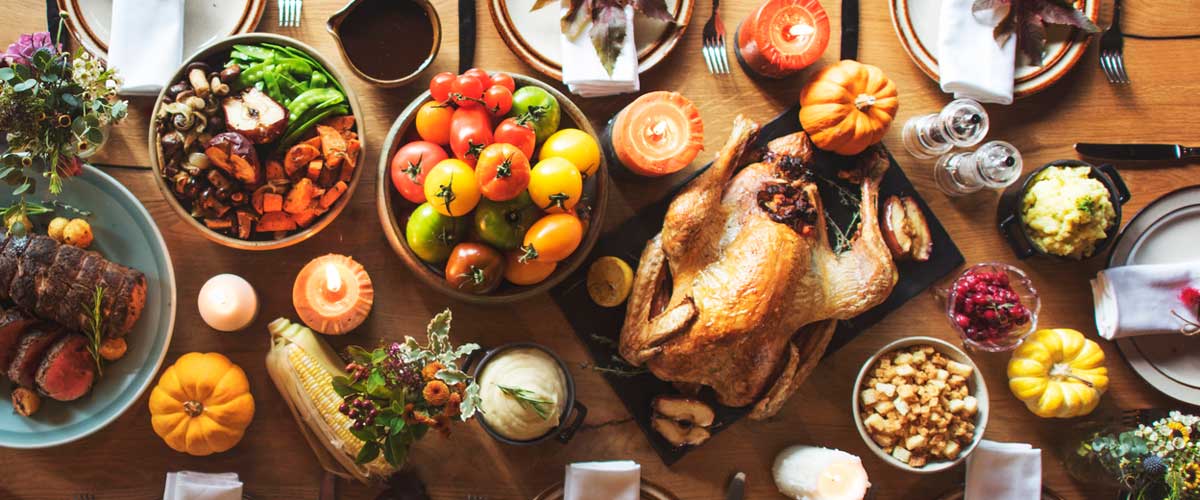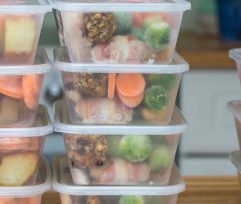There’s no season quite like the holidays: sweater weather, fun decorations, cozy candles and reminders of gratitude. Oh, and of course, all the opportunities to eat. No fall or winter month is complete without large platefuls of warm and delicious comfort food – and there’s certainly nothing wrong with indulging and enjoying yourself. However, if you’re interested in practicing more mindful eating these next few feasting months, here are some of my favorite tips for watching my portions at the dinner table.
1. Don’t skip breakfast
It’s easy to think that restraining yourself prior to dinner will save you calories. However, in my experience, I often end up frantically stuffing my face. When you become that ravenous, 1,000 calories can be consumed in minutes without your body being able to register it’s full in time. So you grab another plate… and then another. And suddenly you’re comatose, as the tryptophan and excess carbohydrates pound your system.
Of course, a large breakfast in the morning is not necessary. A simple egg white omelet, for instance, will do just fine. The high protein content will keep you satisfied throughout the day and in a sounder state of mind during family dinner.
2. Exercise earlier that day
This year, I signed up to run in a 5k “Turkey Trot” on Thanksgiving morning. Not because I want to punish myself, but because exercise fosters my mind body connection. It relieves stress and I’m reminded of how amazing my body is for what it accomplishes everyday. As a result, I’m more motivated to properly fuel my body with the right portion sizes come mealtime. Not to mention, studies show exercise can suppress appetite. If morning runs aren’t your forte, try going for a walk after your big holiday feast. The physical activity will help your body better digest the food, fend off guilt and combat post-meal grogginess.
3. Fill up on protein and veggies first
The first thing I love to eat at any holiday meal is stuffing, ten full servings of bottomless stuffing. However, a trick I now use is reaching for protein and whole veggies first. Protein will slow the release of sugar from carbohydrates into the blood stream, thus helping to prevent future sugar crashes or hunger pangs, and the veggies can be consumed in large, filling amounts with a relatively low caloric intake. The result? I feel more satiated and can serve myself a more reasonable portion of stuffing.
4. Grab a smaller plate
Growing up, I was so confused as to why we only had small dishes in our kitchen. I used to call them “elf plates.” Turns out, Mom was pulling a clever psychological trick. Did you know average dish size has increased 22% since 1960? We’ve become a nation of super-sized portions and most people continue eating without any adaptation.

These portion distortions eventually become consumption size norms. And so, naturally, most people become accustomed to overeating due to a common “clean the plate” mentality. But there are ways to reverse the damage. Studies have shown that people will often eat whatever amount of food is in front of them, regardless if they know better. Gradually downsize your appetite by using smaller plates that force you to take smaller portions. Your brain will think it’s eating a huge plateful of dinner, when in fact you’re eating 75 percent of your usual portions. Sneaky, sneaky.
5. Visualize proper portion sizes
It’s taken me several years to finally pick up macro counting. I knew it would give me competitive edge in my triathlons if I vigilantly tracked portion sizes during training, but I was always so intimidated by the random numbers and measurements. For example, chicken should be three to four ounces per meal. What that actually looked like on my plate, I couldn’t be sure. It’s easy to weigh my food out at home, but what about when I go eat at a restaurant? Or am sitting at the holiday dinner table? I could arguably whip out my food scale for all my cousins and grandparents to see, but most people would consider that excessive. Understandable. So, instead, I utilize visualization to help guesstimate healthy portion sizes. Here are some examples with classic holiday foods:
Turkey
As I stated before, the recommended serving size for chicken, or in this case turkey, at any meal is four ounces. This will give you 32 grams of protein. When it comes time to serve myself, I tell myself this portion equates to roughly the same size of a deck of cards. I also aim for skinless meat, the leaner option.
Dinner Rolls
Who doesn’t love warm rolls? But if you want to avoid being literally “rolled” out of the room, I suggest keeping bread within the visual size of a tennis ball. White bread packs a substantial amount of carbohydrates, all within the higher range of the glycemic index. Eat four tennis balls-worth of bread and your insulin will work overtime, eventually dropping you into low, sad blood sugar levels. See if you can get your hands on whole-wheat rolls. They pack more B vitamins and fiber that’ll help keep you fuller longer.
Pumpkin Pie
I’ll admit, pumpkin pie has some benefits: 50 percent of the recommended daily value of vitamin A and tons of vitamin K, calcium and iron. But its high sugar content is that last thing I want to my body to be binging on. For my portion size, I visualize a light bulb. This will give you, on average, a 160 calorie slice.
Whether you’re training for a competition, looking to loose weight or just adopt healthier eating habits, I encourage you to set realistic goals this holiday season. I don’t suggest anyone go into these next few months swearing off all desserts or comfort foods. Food is more socially and culturally important than most people realized. Never let your relationship with food take priority over building memories with your loved ones. De-stress, stay positive and seek balance over perfection. It’s OK to let a little loose! Merry feasting!




